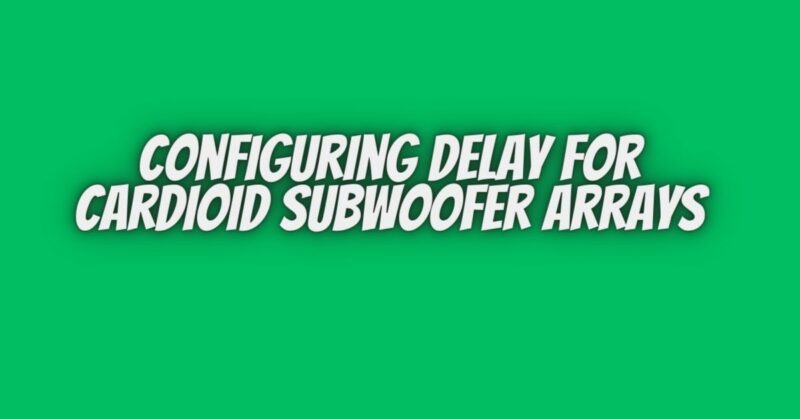Cardioid subwoofer configurations are renowned for their ability to control low-frequency sound dispersion, delivering directional and focused bass. Achieving optimal performance in a cardioid subwoofer array involves not only the strategic placement of subwoofers but also the precise application of delay. In this article, we’ll explore the principles behind delaying subwoofers in a cardioid array and offer guidelines on how to configure delay for optimal results.
Understanding the Basics:
Before delving into the specifics of delaying subwoofers in a cardioid array, it’s essential to grasp the foundational concepts:
- Cardioid Pattern: A cardioid subwoofer configuration creates a directional polar pattern, concentrating the majority of bass energy in the forward direction while minimizing sound radiation to the rear and sides.
- Delay and Phase: Delay is used to align the arrival times of sound waves from different subwoofers in the array. This ensures that the constructive and destructive interference patterns necessary for cardioid dispersion are achieved.
Determining Delay Values:
The process of determining the appropriate delay values for each subwoofer in a cardioid array involves careful measurement and calculation. Here are the steps to guide you:
- Measurement: Use measurement tools such as an RTA (Real-Time Analyzer) or measurement microphone to assess the frequency response at various points in the listening area. Identify locations where the cardioid pattern needs improvement.
- Measurement at Subwoofer Positions: Measure the frequency response at the positions of each subwoofer in the array. This will provide insights into the current performance and any variations in arrival times.
- Alignment Targets: Establish alignment targets based on the desired cardioid pattern. Ideally, the subwoofers at the rear and sides should contribute to cancellation, while the forward-facing subwoofers should reinforce the bass energy.
- Calculate Delay Values: Calculate the delay values for each subwoofer to achieve the desired alignment. The goal is to ensure that the sound waves from each subwoofer arrive at the listening position in phase, reinforcing or canceling each other appropriately.
Delay Implementation:
Once the delay values have been determined, implementing the delay involves adjusting the settings on the system processor or controller. Follow these steps:
- System Processor: Access the system processor or controller responsible for managing the subwoofers. This could be part of a digital signal processor (DSP) or a dedicated controller for the subwoofer array.
- Individual Subwoofer Delays: Input the calculated delay values for each subwoofer. Ensure that the delays are set according to the specific requirements of the cardioid pattern you want to achieve.
- Fine-Tuning: After setting initial delay values, conduct additional measurements to fine-tune the alignment. Adjust the delays incrementally, measuring the impact on the frequency response at the desired listening positions.
- Verify with Measurement: Regularly verify the cardioid pattern and frequency response using measurement tools. Make adjustments as needed to achieve the desired directional bass characteristics.
Considerations and Tips:
- Phase Alignment: In addition to delay, pay attention to the phase relationship between the subwoofers. Ensure that they are in phase at the crossover frequency to avoid phase cancellation issues.
- Room Acoustics: Consider the impact of room acoustics on the performance of the cardioid array. Room reflections and resonances can affect the effectiveness of the cardioid pattern.
- Consult Manufacturer Specifications: Refer to the manufacturer specifications of your subwoofers and system processor for guidance on delay settings and phase alignment.
Conclusion:
Configuring delay for a cardioid subwoofer array is a critical step in achieving precise and controlled bass dispersion. By carefully measuring, calculating, and adjusting delay values, you can optimize the performance of your cardioid subwoofer configuration, ensuring that the bass energy is focused where it’s needed and minimized in unwanted areas. Regular measurements and fine-tuning will help maintain the desired cardioid pattern in various listening positions, creating an immersive and controlled low-frequency experience.


